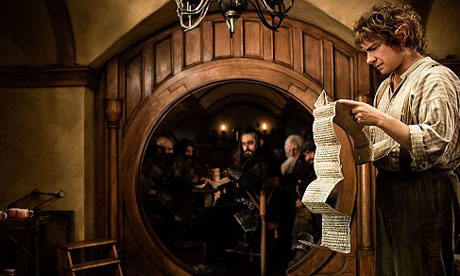
The first screening of extended footage from The Hobbit, Peter Jackson's forthcoming two-part Lord of the Rings prequel, has been met with mixed reactions at the annual CinemaCon event in Las Vegas.
The conference, which allows cinema owners, filmgoers and critics to catch a glimpse of upcoming high-profile movies, featured a presentation from Jackson (via recorded linkup) of footage shot at the higher 48 frames-per-second format, which the film-maker has been championing as the future of cinema. However, Variety reports that some audience members were unconvinced, with actors appearing overlit and sharp in a way that many compared to modern sports broadcasts or daytime television.
"It reminds me of when I first saw Blu-Ray, in that it takes away that warm feeling of film," one chain owner said. "It looked to me like a behind-the-scenes featurette."
"It looked like a made-for-TV movie," another projectionist told the LA Times. "It was too accurate – too clear. The contrast ratio isn't there yet – everything looked either too bright or black."
Another LA film buyer told the Times: "The question is if people want to watch movies that really look real or not. I was expecting a subtle difference, but this was dramatic. Might that work against a narrative? I don't know." But he added: "I'm not going to judge it based on 10 minutes."
Forty eight frames per second was championed by James Cameron at CinemaCon last year during a lengthy presentation. The film-maker says he may shoot his Avatar sequels at an even higher 60 frames per second. Twenty four frames per second has been the cinema standard for more than 80 years, so a permanent switch would represent an entirely new era for cinemas.
In his recorded message, Jackson said higher frame rates could make cinema "more attractive," especially in 3D, as they were "more gentle on the eyes". He said 2D at 48fps also looked "fantastic."
The 10 minutes of footage included action sequences and character-driven moments, including a scene in which Bilbo Baggins (Martin Freeman) encounters Gollum (Andy Serkis). Returning Lord of the Rings cast members such as Ian McKellen (Gandalf), Cate Blanchett (Galadriel) and Orlando Bloom (Legolas) were prominently featured.
Part one of Jackson's project, The Hobbit: An Unexpected Journey, hits cinemas in December, so the Kiwi film-maker still has more than six months to tinker with the footage. Warner Bros said it was not fully colour-corrected and did not feature completed effects work. Another high profile 2012 film, The Dark Knight Rises, caused consternation at the end of last year when its opening scenes were screened in cinemas, only for audiences to complain that they could not understand what the lead villain, Tom Hardy's Bane, was saying. Reports from CinemaCon, where part of the film was also screened, suggest that director Christopher Nolan has now corrected the audio ahead of its 20 July release date.
Jackson's film, based on the 1937 JRR Tolkien children's fantasy novel, is expected to be one of the year's biggest blockbusters, but has had a chequered path to production prompting a steady stream of tabloid stories suggesting a "Hobbit curse". Setbacks include the departure of original director Guillermo del Toro in 2010 after extended delays relating to studio MGM's financial travails, a fire that destroyed a number of vital miniatures, an enormous row with a local New Zealand union which prompted the labour law changes, and Jackson's own hospitalisation last year for surgery to treat a stomach ulcer.

